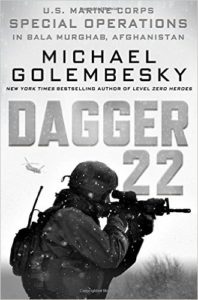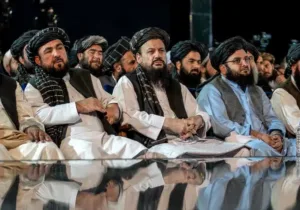In the remote and hostile river valley of Bala Murghab, the unforgiving Afghan winter has descended upon the men of Marine Special Operations Team (MSOT) 8222, call sign Dagger 22. Against them, the Taliban fighters of the region are content to follow their normal tactics and go dormant in order to rest, reequip, and plan for the spring fighting season. Dagger 22, however, has decided this winter would be different.
Prior to the new year, the Marines had consolidated their area of operations, stabilizing and expanding the security around their forward operating base (FOB). They knew, therefore, that the spring offensive would be especially brutal as the Taliban would be keen  to recoup their losses. Knowing that to bring the fight to the Taliban throughout the winter might cripple the enemy’s ability to prosecute an effective spring campaign, the men of Dagger 22 continue to roust the Taliban from one battle to another and shape the terms of battle to their own preferences. Dagger 22: U.S. Marine Corps Special Operations in the Bala, Murghab, Afghanistan is the story of how they do that.
to recoup their losses. Knowing that to bring the fight to the Taliban throughout the winter might cripple the enemy’s ability to prosecute an effective spring campaign, the men of Dagger 22 continue to roust the Taliban from one battle to another and shape the terms of battle to their own preferences. Dagger 22: U.S. Marine Corps Special Operations in the Bala, Murghab, Afghanistan is the story of how they do that.
This is the second volume by Michael Golembesky, a combat veteran of Afghanistan and Iraq, who served eight years with the US Marine Corp. Golembesky—Ski—served as a joint terminal attack controller with MARSOC. JTACs direct the actions of combat aircraft engaged in close air support and other offensive air operations from a forward position. This second battle memoir takes over where Ski’s earlier Level Zero Heroes left off, extending the story and filling in important narrative detail. Written in the vernacular, Dagger 22 is an everyman’s account of martial valor, lethal professionalism, and brotherhood.
But it is also something more. It is also a relentlessly frustrating account of rules of engagement that make an unnecessary hash of the Marines’ ability to prosecute and win the fight. One among many anecdotes will make the point.
In the dead of night, a drone operator working with Ski has acquired visual contact on some guys digging in the middle of the road. Ski continues:
Looking at the screen, it was plain to see. The drone camera was locked onto three individuals milling around the road, working on something. The black and white thermal image was clear, but not good enough to make out in detail exactly what they were doing. One person was on his knees in the center of the road as the other two walked back and forth over a shallow trench that ran alongside.
Ski is a bit astounded at what he sees. The men on the video are less than a half kilometer from the American FOB. “Are these guys emplacing an IED?” he asks aloud, incredulously. The answer was already clear. There was nothing else that three men would be doing at 2300, in the pitch-dark, on a road regularly utilized by the Marines. But approval to bomb the men was not immediately forthcoming. The situation’s criticality deepened when it became apparent that “one of the three was clearly smaller, half the size of the other two, almost like a child…The short individual was clearly in charge of whatever activity they were doing, running back and forth from the side of the road to the man kneeling in the center, at one point walking backward as if to lay wire between the two spots.”
The Marines are convinced they are watching Mullah Muslim, nicknamed the midget, the head IED maker in the region, emplacing one in the middle of the road within yelling distance of their position. Despite repeated requests to attack the men from the air, permission is denied. “A few minutes later,” Ski writes, “the three men finished” and walked away.
To those calling the shots, dozens of miles away, with no real first-hand experience of the area of operations, no intimate knowledge of the behavior of the enemy or area civilians, there could be no way “to be one hundred percent certain that these three people fooling around on the road in the middle of the night were emplacing an IED…and that the short individual was in fact Mullah Muslim and not just some kid helping out his dad and brother.”
Ski is numb with anger. “We knew this area better than anyone else…If that was in fact Mullah Muslim, and we had allowed him to just walk away, anything he did from that point on could have been averted.” Such frustrations are commonplace in Dagger 22.
I’ve written before about the morality of force protection in light of rules of engagement. ROEs are the terms under which warfighters can use lethal force against enemy combatants. Three keys considerations are usually at play: mission effectiveness, force protection (safeguarding one’s own personnel), and non-combatant immunity. I’ve suggested that, in light of moral injury, we ought to allow our warfighters to risk (reasonably) increased physical threat in order to further protect non-combatants—thereby protecting our warfighters from psychic or moral wounds. These kinds of reasonable compromises are not what Dagger 22 is describing.
Instead, what we see presented are engagement decisions being crafted by certain people with less operational information and experience than those in forward positions. Repeatedly throughout Dagger 22, such poor decisions clearly hamper mission effectiveness. One of the effects of this is to build in the minds of the Marines the assumption that “we must be fighting for something other than victory.” This, naturally, has a deleterious effect on resiliency, compromises faith in leadership, and desiccates martial resolve. In other words, it fails in protecting the force. Not only do our warfighters face increased physical harm by being hamstrung in their ability to fight, but they also risk the spiritual wound of feeling betrayed by those in authority over them in the high stakes situation of combat. The Marines in Dagger 22 demonstrate time and again that they are willing to have their lives spent in pursuit of the mission. But they are howling mad at the prospect of having them wasted. The rules of engagement described in Dagger 22 are antithetical to they ought to be: they are mission ineffective, they fail to protect the US forces, and they too often result in enemy-combatant immunity.
A patrol later discovers that the men working in the road were, in fact, emplacing an IED. After disarming it, the Marines confirm the technique, craftsmanship, and materials all suggest the handiwork of Mullah Muslim. Such disastrous leadership takes its toll. When his rotation is up, Golembesky decides to leave the force. “When patriots begin shedding their uniforms,” he writes, “the nation they defend should take notice. Those standing on the ramparts will do so only because of trust in our leaders and love for our country.” Considering the events which he describes in his book, Ski concludes, “Not many of us felt that was still the case” after Bala Murghab. The result is that not just Ski but “most of us left the Volunteer’s War and tried to lose ourselves in the civilian world we’d been so dedicated to defending.”
This should register as a crisis. To read Dagger 22 is to know that America and our allies—including innocent civilians in that Afghan province–are safer having men like the MSOT standing on freedom’s wall. It is at our own peril that we scuttle their willingness to serve.
Throughout the winter offensive, Dagger 22 demonstrates that in battle after battle American warfighters have the ability to paint the operational palette of their own choosing and not of the enemy’s. Despite the challenges of a capable adversary, harsh terrain, bone rattling cold, and tactical restrictions, the MSOT of Dagger 22 is finally, just prior to the full outbreak of the fighting season, able to successfully stage a night time assault to destroy a heavily entrenched Taliban force, breaking their grip on the valley and toppling their ability to launch their much anticipated spring offensive.
Whatever else it is, Dagger 22 is a remarkable testimony to the resistance, bearing, and sheer lethality of a Marine Corps band of brothers. Such men prove, time and again, that the old boast might really be true: they can beat the enemy with one hand tied behind their back.
Good thing, because they often have to.
—
Marc LiVecche is managing editor of Providence
Image: Michael Golembesky, Bala Murghab Archive, photograph taken by Edward Hatch







 Sponsor a student for Christianity & National Security 2024
Sponsor a student for Christianity & National Security 2024